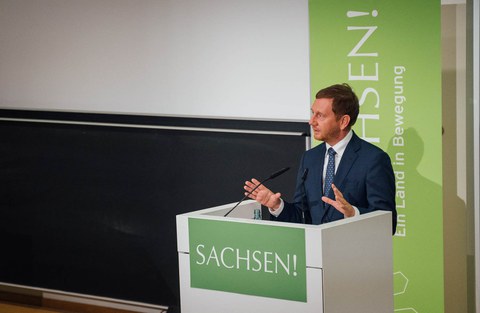Sep 09, 2020
20 years biotechnology offensive in Saxony
15,500 employees, an annual turnover of almost two billion euros, numerous companies and research institutes, especially in Dresden and Leipzig, international degree programmes and two clusters of excellence. The results of Saxony's biotechnology offensive launched in 2000 are impressive.
The Free State of Saxony provided 200 million euros for the launch of the life science locations Dresden and Leipzig. This is how the Biotechnology Center of TU Dresden (BIOTEC) came into being. It has its home in the BioInnovation Centre Dresden, originally with six chairs including junior research groups, and became the nucleus of biotechnological research at TU Dresden.
The BIOTEC intended to combine state-of-the-art research approaches in molecular and cell biology with the traditionally strong engineering sciences in Dresden. It has become the mission of the BIOTEC to conduct interdisciplinary research to make the latest life science findings quickly applicable. Since then, the BIOTEC has focused on molecular cell and developmental biology, physical biology and bioinformatics.
The BIOTEC, which was opened in 2001 as a Central Academic Unit at TU Dresden, has developed over the past 20 years into today's Campus Johannstadt with the Center for Regenerative Therapies Dresden (CRTD), founded in 2006, the Center for Molecular Bioengineering (B CUBE), founded in 2008, and the Center for Molecular and Cellular Bioengineering (CMCB), created in 2016 as the umbrella organisation for all three institutes.
Today, the biotech industry met at the Life Sciences Forum Saxony at the CRTD of TU Dresden to look back on 20 years of Saxony's biotechnology offensive and to discuss the health technologies of the future.
Overall, the institutes of the Johannstadt Campus have had a lasting impact on the Research Priority Area "Health Sciences, Biomedicine and Bioengineering" of TU Dresden. With their two Clusters of Excellence CRTD (funded from 2006 to 2019) and Physics of Life (PoL), they have played a decisive role in the success of the university in the federal and state Excellence Initiative since 2012.
"With their research, the scientists of the CMCB make a significant contribution to the excellent and globally recognised development of the life sciences at TU Dresden. In cooperation with the extramural scientific institutions, they form a strong and internationally competitive center for bioengineering with a broad scientific background, ranging from molecular and cell biology, medicine, physics, chemistry, materials science to bioinformatics," says Prof. Staudinger.
Particular priority is given to application-orientated research on the Johannstadt campus: The basic researchers work closely with scientists from the Carl Gustav Carus University Hospital and the Carl Gustav Carus Faculty of Medicine, but also with many extramural institutions that have settled in Dresden in recent years.
These include the Max Planck Institute of Molecular Cell Biology and Genetics, founded in 2001, the Max Planck Institute of Physics of Complex Systems, the Center for Systems Biology Dresden, the Deutsches Zentrum für Neurodegenerative Erkrankungen, the German Center for Diabetes Research, the Max Bergmann Center of Biomaterials Dresden, the National Center for Radiation Research in Oncology (OnkoRay) and various spin-off companies.
Facts and figures:
- 2006: Foundation of DFG Research Centre and Cluster of Excellence for Regenerative Therapies Dresden (CRTD)
- 2008: Foundation of B CUBE - Center for Molecular Bioengineering as Centre for Innovation Competence (ZIK) by the initiative "Unternehmen Region" of the Federal Ministry of Education and Research
- 2016: Foundation of the Center for Molecular and Cellular Bioengineering (CMCB) as an umbrella organisation of the three institutes BIOTEC, CRTD and B CUBE with three international master degree programmes and a common technology platform, such as the Dresden-concept Genome Center or the Biopolis Dresden Imaging Platform
- 2018: Foundation of the DFG Cluster of Excellence Physics of Life (POL)
- Introduction of three international Master's degree programmes (teaching entirely in English, proportion of international students around 70 %:
- 2002: Molecular Bioengineering
- 2007: NanoBiophyscis
- 2010: Regenerative Biology and Medicine
- 2020: 29 TUD chairs at the CMCB and PoL (some still being appointed), plus 20 independent early-career research groups
- CMCB: about 500 employees, around 35 % hailing from outside Germany from 30 different nations, language of communication English
Media enquiry:
Press Office TU Dresden
Kim-Astrid Magister
Telephone: +49 351 463 -32398

